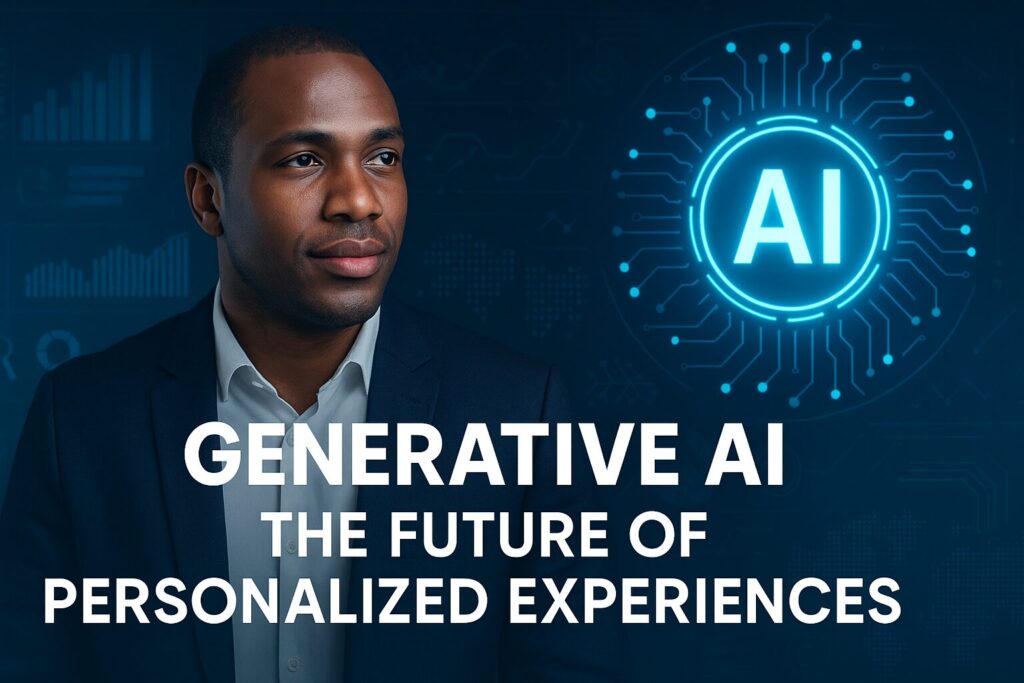Generative AI: The Future of Personalized Customer Experiences 🚀
Introduction

Personalization has been the dream of every business leader for decades. From inserting a customer’s first name into emails to tailoring ads based on browsing history, brands have always sought ways to make experiences feel personal.
But here’s the truth: traditional personalization has reached its limits. Consumers today demand more than a product recommendation or a catchy subject line. They want interactions that feel authentic, adaptive, and made just for them.
Enter Generative AI — a technology that doesn’t just predict what customers want but actually creates personalized experiences in real time. From dynamic ad copy to AI-powered chatbots and adaptive landing pages, generative AI is redefining what personalization means in the digital age.
In this article, we’ll dive into how generative AI is changing customer experiences, why it matters for your business, and how you can leverage it for sustainable growth.
1. The Evolution of Personalization
Let’s rewind.
- Early personalization: demographic segmentation (age, gender, location).
- Next wave: behavioral targeting (cookies, past purchases, website browsing).
- Machine learning era: predictive analytics to forecast customer needs.
Now we’ve arrived at a new stage: Generative AI.
Unlike predictive models that just analyze and forecast, generative AI can produce content, conversations, and entire experiences tailored to the customer.
Imagine logging into a website and seeing:
- Copy written in your preferred tone.
- Product recommendations styled exactly how you like.
- Visuals and layouts that shift based on your taste.
That’s the power of real-time adaptive personalization.
2. Why Generative AI is a Game Changer
Generative AI works because it combines creativity, context, and scale. Here’s why it’s revolutionary:
🔹 Hyper-Scalable Creativity
No more limited ad variations. AI can generate thousands of personalized creatives instantly.
🔹 Real-Time Contextual Relevance
AI adapts to signals like browsing behavior, time of day, or even emotional tone.
🔹 Human-Like Conversations
Chatbots powered by generative AI don’t sound robotic. They can respond with empathy and nuance.
This isn’t personalization that feels “close enough.” It’s personalization that feels alive.
3. Real-World Business Applications
Top brands are already leveraging generative AI to reshape experiences:
- Coca-Cola → AI-generated ads for regional audiences.
- Netflix → AI-curated thumbnails unique to each user.
- Stitch Fix → AI-generated fashion suggestions blending inventory with style models.
- Finance brands → AI-written investment advice emails tailored to goals and risk tolerance.
Generative AI is moving beyond pilot projects — it’s becoming a mainstream growth driver.
4. The Psychology Behind Personalization
Why do people love personalization?
- Recognition: Customers feel seen and valued.
- Convenience: Saves time, reduces decision fatigue.
- Emotion: Surprise and delight build loyalty.
Generative AI taps into this psychology by providing effortless, emotionally resonant experiences.
5. The TikTok Effect: Redefining Expectations
TikTok changed everything.
Within minutes, its algorithm knows your interests better than your closest friends. That’s the new gold standard.
Generative AI brings TikTok-level personalization to websites, apps, and ads. If your brand isn’t delivering that, customers will go elsewhere.
6. How to Use Generative AI in Your Business Today
Here are actionable ways businesses can start right now:
- Content at Scale → AI-generated blogs, product descriptions, personalized emails.
- Conversational AI → Empathetic chatbots and virtual assistants.
- Dynamic Visuals & Video → Personalized demo videos and adaptive landing pages.
- Predictive Personalization → Anticipating customer needs before they realize them.
These aren’t futuristic experiments—they’re competitive advantages available now.
7. Mistakes to Avoid
With great power comes responsibility. Common mistakes:
- 🚫 Over-automation without oversight.
- 🚫 Creepy personalization (too much data feels invasive).
- 🚫 Generic AI outputs (lacking fine-tuning).
- 🚫 Ignoring ethical bias in datasets.
Successful companies will balance AI automation with human creativity and ethics.
8. The Future of Personalized AI Experiences
Where’s it all heading?
- AI-powered metaverse stores that adapt to individual tastes.
- Personalized AI voices matching emotional tones.
- Co-creation with customers to design products.
- Adaptive storytelling in media and entertainment.
Tomorrow’s experiences will be co-created by customers and AI.
FAQ Section
❓ What is generative AI in customer experience?
Generative AI creates new, personalized outputs like ads, chat responses, and visuals tailored to individual customers in real time.
❓ How is this different from predictive analytics?
Predictive analytics forecasts what customers may want. Generative AI creates actual experiences and content based on those insights.
❓ Can small businesses use generative AI?
Absolutely. Tools are increasingly accessible—AI-generated emails, chatbot platforms, and content creation software are affordable even for startups.
❓ What are the risks?
The biggest risks are over-automation, privacy concerns, and bias in training data. Human oversight is key.
❓ Will AI replace human marketers?
No. It will augment human creativity by automating repetitive tasks and freeing marketers to focus on strategy and storytelling.
Conclusion
Generative AI is not just a tool—it’s a paradigm shift in how businesses engage customers. By creating personalized, human-like experiences at scale, it is reshaping the future of marketing and customer loyalty.
If your brand wants to stay ahead, the time to adopt generative AI is now. Start small, experiment, learn fast, and scale strategically.
The future of business is not just digital. It’s personal.
📌 Viral Image Prompt for WordPress Blog
Use this image concept for your blog header:
Prompt: A photo-realistic Black business professional using futuristic AI technology on a digital holographic interface. The background shows glowing charts, analytics, and AI patterns. Bold, centered text reads: “Generative AI: The Future of Personalized Experiences.” Size: 1200 x 630 pixels.
